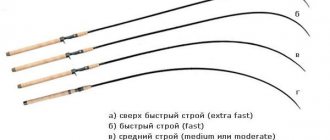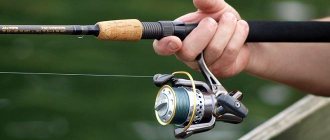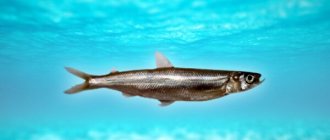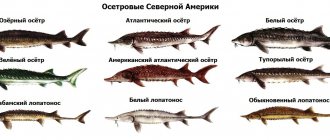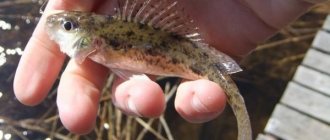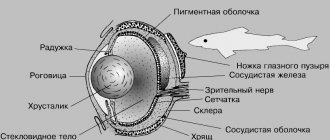Organ of vision
Vision
- one of the main sense organs in fish. The eye consists of a round shaped lens that has a hard structure. It is located near the cornea and allows you to see at a distance of up to 5 m at rest, maximum vision reaches 10-14 m.
The lens captures many light rays, allowing you to see in several directions. Often the eye has an elevated position, so it receives direct rays of light, oblique, as well as from above, below, and from the sides. This significantly expands the fish’s field of vision: in the vertical plane up to 150°, and in the horizontal plane up to 170°.
Monocular vision
– the right and left eyes receive a separate image. The eye consists of three membranes: the sclera (protects from mechanical damage), the vascular (supplies nutrients), and the retinal (provides light perception and color perception due to the system of rods and cones).
Test with answers on the topic: “Pisces”
1. What type of circulatory system do fish have? 1) Open 2) Absent 3) Closed+
2. What covers the body of the bony perch fish? 1) scales+ 2) chitin 3) shell 4) limescale
3. Where are the gill arches attached in the body of the perch? 1) on the ribs 2) in the skull+ 3) on the fins 4) on the spine
4. How do fish breathe? 1) Water washes the gills when moving + 2) When drinking fish 3) With the help of a swim bladder
5. Only representatives of the Pisces superclass are characterized by the presence of a special sensory organ: 1) eyes 2) inner ear 3) lateral line + 4) taste buds
6. The smallest blood vessel in the body of a fish is 1) vein 2) aorta 3) artery 4) capillary+
7. Which part of the fish’s body is the rudder? 1) Side fins 2) Head 3) Caudal fin+
8. Why is a swim bladder needed in a fish’s body? 1) nutrition 2) breathing 3) regeneration 4) vertical movement in water+
9. What happens to sharks' gill covers? 1) absent+ 2) located on the head 3) formed by fins 4) cover the gill slits
10. What is the function of paired fins? 1) Horizontal position of fish + 2) High speed of movement 3) Vertical position of fish
11. Which shark fins are paired? 1) dorsal 2) pectoral + 3) caudal 4) anal
12. Who from the list is a representative of cartilaginous fish? 1) sturgeon+ 2) shark 3) pike 4) coelacanth
13. Whose skeleton of paired fins is similar to the limbs of terrestrial vertebrates? 1) perch 2) sturgeon 3) sharks 4) coelacanths+
14. Why do fish need mucus? 1) Protects from mechanical damage 2) Helps to move in water + 3) Protects from salt
15. Who is characterized by the bony skeleton as a support for the body? 1) sharks 2) perch+ 3) lancelet 4) crab
16. Where is the spinal cord of a fish located? 1) in the skull 2) inside the notochord 3) in the spine+ 4) in the dorsal fin
17. What is a characteristic feature of the structure of fish? 1) no heart 2) two-chamber heart+ 3) three-chamber heart 4) four-chamber heart
18. What are scales needed for? 3) Protects from mechanical damage + 4) Helps to move in water 5) Helps protect against salt
19. How are the respiratory organs of fish represented? 1) skin 2) gills + 3) trachea 4) pulmonary sacs
20. Which organ in the digestive system of fish produces bile? 1) liver+ 2) stomach 3) intestines 4) pancreas
21. Select a sign of cartilaginous fish: 1) Mouth opening on the upper side of the head + 2) Absence of a mouth opening 3) Mouth opening on the underside of the head
22. What is the skeleton of adult sharks? 1) represented by a notochord 2) cartilaginous+ 3) bone 4) external
23. Compared to bony fish, what do sharks lack? 1) heart 2) intestines 3) swim bladder + 4) organ of vision
24. What is the body of a fish not covered with? 1) Shell 2) Mucus 3) Scales+
25. Lungfishes are characterized by the presence of: 1) pulmonary respiration + 2) paired fins 3) gills 4) skull
Hearing organ
Hearing aid
(inner ear or labyrinth) located in the back of the skull, includes two compartments:
the upper oval and round lower sacs
.
The oval sac contains three semicircular canals - this is an organ of balance; endolymph flows inside the labyrinth; in cartilaginous fish it connects with the environment through the excretory duct; in bony fish it ends blindly. The organ of hearing in fish is combined with the organ of balance.
The inner ear is divided into three chambers, each containing the otolith (part of the vestibular apparatus that responds to mechanical irritation). The auditory nerve ends inside the ear, forming hair cells (receptors); when the position of the body changes, they are irritated by the endolymph of the semicircular canals and help maintain balance.
The perception of sounds is carried out due to the lower part of the labyrinth - a round sac. Fish are able to detect sounds in the range of 5Hz – 15kHz. The hearing aid includes the lateral line (allows you to hear low-frequency sounds) and the swim bladder (acts as a resonator, connected to the inner ear through the Weberian apparatus
, consisting of 4 bones).
Pisces are myopic animals
, often move in muddy water, with poor lighting; some individuals live in the depths of the sea, where there is no light at all. What sense organs and how do they allow one to navigate in water under such conditions?
Organs of smell, taste, touch in fish
Olfactory organs
In fish, as in other vertebrates, they are located in the front part of the head and are represented by paired olfactory (nasal) sacs (capsules) that open outward with nostril openings. The bottom of the nasal capsule is lined with folds of epithelium, consisting of supporting and sensory cells (receptors). The outer surface of the sensory cell is equipped with cilia, and the base is connected to the endings of the olfactory nerve. The olfactory epithelium contains numerous cells that secrete mucus.
The nostrils are located in cartilaginous fish on the underside of the snout in front of the mouth, in bony fish - on the dorsal side between the mouth and eyes. Cyclostomes have one nostril, real fish have two. Each nostril is divided into two openings by a leathery septum. Water penetrates the anterior one, washes the cavity and exits through the rear hole, washing and irritating the hairs of the receptors. Under the influence of odorous substances, complex processes occur in the olfactory epithelium: the movement of lipids, protein-mucopolysaccharide complexes and acid phosphatase.
The size of the nostrils is related to the lifestyle of the fish: in active fish they are small, since during fast swimming the water in the olfactory cavity is quickly renewed; In sedentary fish, on the contrary, the nostrils are large; they allow a larger volume of water to pass through the nasal cavity, which is especially important for poor swimmers, in particular those living near the bottom.
Fish have a subtle sense of smell, that is, their thresholds of olfactory sensitivity are very low. This especially applies to nocturnal twilight fish, as well as those living in turbid waters, for which vision helps little in finding food and communicating with relatives. The sensitivity of smell in migratory fish is most surprising. Far Eastern salmon accurately find their way from their feeding grounds in the sea to their spawning grounds in the upper reaches of rivers, where they hatched several years ago. At the same time, they overcome enormous distances and obstacles - currents, rapids, rifts. However, fish follow the path correctly only if their nostrils are open; if the sense of smell is turned off (the nostrils are filled with cotton wool or Vaseline), then the fish walk randomly. It is believed that at the beginning of migration, salmon orient themselves by the sun and, approximately 800 km from their native river, accurately determine their path thanks to chemoreception.
In experiments, when the nasal cavity of these fish was washed with water from their native spawning ground, a strong electrical reaction occurred in the olfactory bulb of the brain. The reaction to water from downstream tributaries was weak, and the receptors did not react at all to water from other spawning grounds.
Juvenile sockeye salmon Oncorhynchus nerka can distinguish, using the cells of the olfactory bulb, the water of different lakes, solutions of various amino acids in a dilution of 10-4, as well as the concentration of calcium in water. No less striking is the similar ability of the European eel, migrating from Europe to spawning grounds located in the Sargasso Sea. It is estimated that the eel is able to recognize the concentration created by diluting 1 g of phenylethyl alcohol in a ratio of 1: 3 x 10-18. High selective sensitivity to histamine was found in carp.
The olfactory receptor of fish, in addition to chemical ones, is capable of perceiving mechanical influences (flow jets) and temperature changes.
Organs of taste
They are represented by taste buds, formed by clusters of sensory (and supporting) cells. The bases of the sensory cells are intertwined with the terminal branches of the facial, vagus and glossopharyngeal nerves.
The perception of chemical stimuli is also carried out by the free nerve endings of the trigeminal, vagus and spinal nerves. The perception of taste by fish is not necessarily associated with the oral cavity, since taste buds are located both in the oral mucosa and on the lips, and in the pharynx, on the antennae, gill filaments, fin rays and throughout the surface of the body, including the tail.
Catfish perceive taste mainly with the help of their whiskers: it is in their epidermis that clusters of taste buds are concentrated. In the same individual, the number of taste buds increases as the body size increases. Pisces distinguish the taste characteristics of food: bitter, salty, sour, sweet. In particular, the perception of salinity is associated with a pit-shaped organ located in the oral cavity.
The sensitivity of the taste organs in some fish is very high: for example, the cave fish Anoptichthys, being blind, sense a glucose solution at a concentration of 0.005%.
Lateral line sensory organs
A specific organ, characteristic only of fish and amphibians living in water, is the organ of the lateral sense, or lateral line. These are seismosensory specialized skin organs. The lateral line organs are most simply arranged in cyclostomes and cyprinidae larvae. Sensing cells (mechanoreceptors) lie among clusters of ectodermal cells on the surface of the skin or in small pits. At the base they are entwined with the terminal branches of the vagus nerve, and in the area rising above the surface they have cilia that perceive water vibrations. In most adult teleosts, these organs are canals embedded in the skin, extending along the sides of the body along the midline. The channel opens outward through holes (pores) in the scales located above it.
Branches of the lateral line are also present on the head. At the bottom of the canal (in groups there are sensory cells with cilia. Each such group of receptor cells, together with the nerve fibers in contact with them, forms the organ itself - a neuromast. Water flows freely through the canal, and the cilia sense its pressure. In this case, nerve impulses of different frequencies arise. Organs The lateral line is connected to the central nervous system by the vagus nerve.
The lateral line can be complete, that is, stretch along the entire length of the body, or incomplete and even absent, but in the latter case the head canals are strongly developed (in herrings). The lateral line allows the fish to sense changes in the pressure of flowing water, low-frequency vibrations (oscillations), infrasonic vibrations, and for many fish, electromagnetic fields. The lateral line picks up the pressure of a flowing, moving stream; it does not perceive changes in pressure with immersion to depth. By detecting fluctuations in the water column, the lateral line organs enable the fish to detect surface waves, currents, underwater stationary objects (rocks, reefs) and moving objects (enemies, prey), swim day and night, in muddy water, and even while blinded. This is a very sensitive organ: migratory fish sense even very weak currents of fresh river water in the sea.
The ability to catch waves reflected from living and inanimate objects is very important for deep-sea fish, since in the darkness of great depths the usual visual perception of surrounding objects and communication between individuals is impossible.
It is assumed that the waves created during the mating games of many fish, perceived by the lateral line of the female or male, serve as a signal for them. The function of the skin sense is performed by the so-called skin buds - cells found in the integument of the head and antennae, to which nerve endings are suitable, but they are of much less importance.
Organs of touch
The organs of touch are clusters of sensory cells (tactile bodies) scattered over the surface of the body. They perceive the touch of solid objects (tactile sensations), water pressure, as well as temperature changes (heat-cold) and pain.
There are especially many sensory skin buds in the mouth and lips. In some fish, the function of the organs of touch is performed by the elongated rays of the fins: in gourami this is the first ray of the pelvic fin, in the trigla (guinea cock) the sense of touch is associated with the rays of the pectoral fins, feeling the bottom, etc. In inhabitants of turbid waters or bottom fish, the most active at night, the largest number of sensory buds are concentrated on the antennae and fins. However, in catfish, the whiskers serve as receptors for taste, not touch.
Fish apparently feel mechanical injuries and pain less than other vertebrates: sharks that have attacked prey do not react to blows to the head with a sharp object; During operations, fish are often relatively calm, etc.
Thermoreceptors. They are the free endings of sensory nerves located in the surface layers of the skin, with the help of which fish perceive water temperature. There are receptors that perceive heat (thermal) and cold (cold). Points of heat perception are found, for example, on the pike’s head, and cold perception points are found on the surface of the body. Bony fish detect temperature changes of 0.1–0.4°C.
Electric sense organs
The organs for sensing electric and magnetic fields are located in the skin over the entire surface of the fish’s body, but mainly in different parts of the head and around it. They are similar to the lateral line organs - these are pits filled with a mucous mass that conducts current well; At the bottom of the pits there are sensory cells (electroreceptors) that transmit nerve impulses to the brain. Sometimes they are part of the side line system. The ampullae of Lorenzini also serve as electrical receptors in cartilaginous fish. The information received by the electroreceptors is analyzed by the lateral line analyzer (in the prolongata oblongata and cerebellum). The sensitivity of fish to current is high – up to 1 µV/cm2. It is believed that the perception of changes in the Earth's electromagnetic field allows fish to detect the approach of an earthquake 6–8 and even 22–24 hours before the start, within a radius of up to 2 thousand km.
Side line
First of all, this is the side line
- the main sensory organ in fish. It is a channel that runs under the skin along the entire body and branches in the head area, forming a complex network. It has holes through which it communicates with the environment. Inside there are sensitive kidneys (receptor cells) that perceive the slightest changes around.
This way they can determine the direction of the current, navigate the area at night, and sense the movement of other fish, both in a school and of predators approaching them. The lateral line is equipped with mechanoreceptors; they help aquatic inhabitants to dodge pitfalls and foreign objects, even in poor visibility.
The lateral line can be complete (located from the head to the tail), incomplete, or can be completely replaced by other developed nerve endings
.
If the lateral line is injured, the fish will no longer be able to survive for long, which indicates the importance of this organ. The lateral line of fish is the main organ of orientation
Hook!
A spoon or jig moving in the water is also felt by the fish and either causes a grasping reflex or causes it to instantly hide.
The better the spoon imitates the movement of aquatic organisms, the greater the chances that it will be caught. The hearing organs of fish also perceive vibrations in the aquatic environment, but only higher frequency, harmonic or sound ones. They are structured more simply than other animals. Fish have neither an outer nor a middle ear: they do without them due to the higher permeability of water to sound. There is only the membranous labyrinth, or inner ear, enclosed in the bony wall of the skull.
Electroreception
Electroreception
– a sensory organ of cartilaginous fish and some bony fish (electric catfish). Sharks and rays sense electric fields using ampullae of Lorenzini - small capsules filled with mucous contents and lined with specific sensitive cells, located in the head area and communicate with the surface of the skin using a thin tube.
Very susceptible and capable of sensing weak electric fields (the reaction occurs at a voltage of 0.001 mKV/m).
Thus, electrosensitive fish can track down prey hidden in the sand thanks to the electric fields that are created when muscle fibers contract during breathing.
Lateral line and electrosensitivity
– these sense organs are characteristic only of fish!
Olfactory organ
Smell
carried out using cilia located on the surface of special bags. When the fish smells the smell, the sacs begin to move: they contract and expand, capturing odorous substances. The nose includes 4 nostrils, sent out by many sensory cells.
With their sense of smell they easily find food, relatives, and a partner for the spawning period. Some individuals are able to signal danger by releasing substances to which other fish are sensitive. It is believed that the sense of smell for aquatic inhabitants is more important than vision.
Features of sensory organs in bony and cartilaginous
Inert fish have a swim bladder, which perceives a wider range of sounds; cartilaginous fish do not have it, and they also do not have a complete division of the inner ear into oval and round sacs.
Color vision is characteristic of teleosts, since their retina contains both rods and cones. The cartilaginous visual sensory organ includes only rods that are not capable of distinguishing colors.
Sharks have a very keen sense of smell; the anterior part of the brain (provides the sense of smell) is much more developed than other representatives.
Electrical organs are special organs of cartilaginous fish (rays). They are used for protection and attack on the victim, and discharges with a power of up to 600V are generated. They can act as a sensory organ - by forming an electric field, stingrays detect changes when foreign bodies enter it.
Chemical reception organs serve to obtain information about substances dissolved in water and the taste of food. They include: 1) olfactory organs; 2) organs of chemical non-olfactory reception.
The organs of smell (olfactory sacs) are located in the nasal cavity. Fish usually have paired nasal openings (nostrils). The nostril is divided by a leathery valve and has two openings; water enters the olfactory sac through the anterior opening and exits through the posterior one. The cavity of the olfactory sac has folds (rosettes) and is lined with mucous membrane associated with nerve endings. The olfactory nerves coming from the forebrain and the fibers of the trigeminal nerve approach the olfactory organs.
Cyclostomes have an unpaired olfactory organ (in hagfishes it communicates with the pharynx, in lampreys it does not). In lampreys, the nostril leads into a long canal, the posterior wall of which forms an olfactory capsule with sensory cells. The canal continues to the beginning of the notochord, forming a pituitary process. The pituitary gland is adjacent to the upper part of this outgrowth. The olfactory canal of lampreys is also called the nasopituitary canal. The movement of water (taking it in and pushing it back) in the olfactory capsule is carried out by changing the volume of the pituitary outgrowth. In hagfishes, the pituitary process opens with an opening into the oral cavity, so in a hagfish buried in the mud, water can flow to the gill sacs through the nostrils.
Fish have paired olfactory organs. In cartilaginous fish, paired nostrils are usually located on the ventral side of the snout. In all fish (with the exception of lungfishes and lobe-finned fish), the nostrils do not communicate with the pharyngeal cavity.
With the help of the olfactory organs, fish find food, distinguish gender, the physiological state of fish, and orient themselves in space. Some species are very sensitive to odors (sharks, anadromous salmon, burbot, eel, etc.). Thus, sharks are able to recognize the smell of blood at a distance of up to 2 km.
Fish are sensitive to danger signals and to substances released from the skin when injured. The reaction of fish is different: some bury themselves in the mud, others hide, others jump out of the water, etc. The olfactory organs play an important role during fish migrations. Thus, salmon fish remember the smell (chemical composition) of the river in which they hatched from eggs, and several years after feeding in the sea, they return to reproduce in their native reservoir (the phenomenon of homing - finding a home). Experiments with tagging of larvae showed that out of 13 thousand fish caught at spawning grounds, 34% entered exactly the rivers and streams where they hatched from eggs, 65% into neighboring ones, and only 1% were caught at a considerable distance from the tagging sites.
The organs of chemical non-olfactory reception perceive various chemical indicators of the environment (salinity, active reaction of the environment, carbon dioxide concentration, etc.) and are represented by: 1) taste buds (a cluster of sensory cells); 2) taste cells (ball-shaped, bush-shaped, fusiform); 3) free nerve endings.
In fish, the center of chemical non-olfactory reception is located in the medulla oblongata.
Taste buds and cells are located mainly in the oral mucosa, on the antennae, gills, head, and fin rays. Pisces distinguish shades of taste (sweet, bitter, salty, sour). The pungency of taste is associated with the ecological characteristics of the species (food specialization, type of habitat, degree of development of other receptors). Thus, the blind Mexican cave fish recognizes a glucose solution at a concentration of 0.005%.
Pisces are able to perceive tactile (touch, pressure), pain, and temperature sensations. Tactile sensations are perceived through the senses of touch. These include tactile corpuscles (a cluster of sensory cells) scattered over the surface of the body. Many tactile points are located on the head, antennae and fins of the fish. Pisces have low pain sensitivity due to the low level of development of the nervous system.
Fish are very sensitive to temperature changes. Water temperature is perceived by fish using thermoreceptors (free nerve endings) located in the surface layers of the skin. Small deviations in water temperature can change the migration routes and timing of fish spawning. Bony fish are able to distinguish between temperature differences of 0.4°C.
N.V. ILMAST. INTRODUCTION TO ICHTHYOLOGY. Petrozavodsk, 2005
Smell and taste The olfactory organ is formed by a pair of small nasal pits, which are lined with olfactory epithelium. The olfactory organ of fish perceives chemical irritants from substances dissolved in water. The sense of smell is especially developed in fish that search for food at night - carp, eel and bream. Fish have a well-developed taste organ. They distinguish between salty, sour, sweet and bitter tastes. Taste buds are found in the mouth, along the edges of the jaws and on the antennae. Fish that lack antennae have a poorly developed taste. From the point of view of fly fishing and spinning, this sense organ is not important. The main components of taste are four components: sour, sweet, salty and bitter. The remaining types of taste are combinations of these four sensations, and taste sensations in fish can only be caused by substances dissolved in water. The minimal perceptible difference in the concentration of solutions of substances is the threshold of difference - gradually worsens when moving from weak to stronger concentrations. For example, a one percent sugar solution has an almost maximally sweet taste, and a further increase in its concentration does not change the taste sensation.
With prolonged contact of any substance with the organ of taste, its perception gradually becomes dulled, and in the end this substance will seem completely tasteless to the fish. Positive or negative reactions of fish are determined by their lifestyle and, above all, the nature of their diet. Positive reactions to sugar are characteristic of animals eating plant and mixed foods. The feeling of bitterness causes a negative reaction in most living beings, but not in those that eat insects. The sense of smell is closely connected with other senses: taste, vision and balance. At different times of the year, the olfactory sensations of fish are not the same; they become more intense in spring and summer, especially in warm weather. Extracts from the internal organs of predators - pike, swimming swimmers, water striders, and water bugs - repel roach and crucian carp. According to many scientists, animals are guided by a mixture of basic odors: musky, camphor, mint, ethereal, floral, pungent and rotten. These odors make up all the odors found in nature. You should not keep wounded fish in a cage while fishing or cut them in the water at the fishing site (especially predatory fish).
Hearing organs The auditory function in fish is carried out, according to experts, in addition to the main organ of hearing, the lateral line, the swim bladder, as well as specific nerve endings. Anatomically, like all vertebrates, the main organ of hearing, the ear, is a paired organ and forms a single whole with the organ of balance. The only difference is that fish do not have ears and eardrums, since they live in a different environment. The hearing organs of fish developed in an aquatic environment, which conducts sound 4 times faster and over longer distances than the atmosphere. The range of sound perception in fish is much wider than in many land animals and people. In the lateral line of the fish, formations were discovered that record acoustic and other water vibrations. It has been established that fish are able to detect 10 times less frequency changes than humans. The swim bladder is believed to act as a resonator and transducer of sound waves, which increases hearing acuity. It also performs a sound-producing function. Paired organs located in the lateral line of fish perceive sound vibrations in a panoramic manner, which allows fish to clearly establish the direction and location of the source of vibration. Fish distinguish near and far zones of the acoustic field. In the near field, they clearly determine the location of the source of the vibration, but scientists have not yet determined whether they can determine the location of the source in the far field. Pisces also have an amazing “device” - a signal analyzer. Thanks to this organ, fish are able to isolate from all the chaos of sounds and vibrational manifestations around them the signals that are necessary and important for them, even those weak ones that are at the stage of emerging or on the verge of fading. Fish are able to amplify these weak signals and then perceive them with analyzing formations. Fish widely use sound signaling; they are capable of both perceiving and emitting sounds in a wide range of frequencies. I would like to draw the readers’ attention to the perception of infrasonic vibrations by fish, which, in my opinion, is of great importance in the life of fish. It is believed that frequencies equal to 4-6 hertz have a detrimental effect on living organisms, since these vibrations resonate with the vibrations of the body itself or individual organs and destroy them. It is possible that fish react to the approach of inclement weather by perceiving low-frequency acoustic vibrations emanating from approaching cyclones. On this basis, it can be assumed that fish are able to predict weather changes long before they occur; fish detect these changes by the difference in the strength of sounds, and possibly by the level of interference for the passage of waves of a certain range. There is evidence that fish are capable of echolocation.
Location sensitivity organs of fish No one doubts that fish use location in their lives. Radar and sonar, integral components of this organ, were found in the lateral line of the fish. It is possible that fish use low-frequency waves of a wide range for location. It is believed that these waves serve fish for communication purposes. Hydroacoustic studies have shown that fish are too “chatty” for an unreasonable creature; they produce too many sounds, and “conversations” are conducted at frequencies that are beyond the normal range of perception by their primary organ of hearing. It is unlikely that this “chattyness” has only a communication value; this conversation would be too attractive for predators. These signals are more appropriate as location signals sent by fish radars. It is believed that low-frequency waves are poorly reflected (badly, but not completely!) from small objects, since due to their length they simply flow around objects. But these waves have a number of advantages over ultrashort ones: they are less absorbed by water, are heard over long distances, propagate evenly in all directions from the sound source, their use for location makes it possible to panoramic “seeing and hearing” the surrounding space. And if fish, for location purposes, send a whole series of signals of different frequencies, then a panoramic survey is guaranteed. This will also help compensate for the lack of reflected signals. Considering the high sensitivity of fish’s sensory organs, it can be assumed that they can use these reflected signals. I hope that the above confirms that location occurs in fish and we should agree with the existence of an organ of location sensitivity. This is an independent organ, and despite the fact that sound waves are used for its operation, it cannot be classified as an organ of hearing. This is an important sensory organ for the life of fish. It remains to be found out what frequencies fish use for location?
We continue our traditional column Tips from experienced fishermen - we’ll tell you about the sensory organs of fish:
Navigation: About fish - organs, instincts
Nervous system and sensory organs of fish
1. The nervous system of fish is represented by the brain and spinal cord
. The brain is divided into the following sections: forebrain, diencephalon, midbrain, cerebellum and medulla oblongata. Twelve cranial nerves, grouped in pairs, extend from the brain.
2. At the forebrain
there is no division into hemispheres, and accordingly, there is almost no cortex. At its anterior end are the olfactory lobes.
3. From intermediate
and
the midbrain,
the optic nerves go to the eyes. The midbrain of most fish is small. It contains the centers of visual reflexes.
4. Cerebellum
responsible for the movements of the fish, it is well developed.
5. Medulla
responsible for the functioning of the digestive system, the functioning of the respiratory center, heart and other organs.
Sense organs
1. Olfactory organs
- one nostril in cyclostomes and paired nostrils in all other fish, from which openings lead into the olfactory cavities, which are not connected, as is typical for fish, with the oral cavity. How do fish smell in water? The nostril is divided by a septum into two halves, water flows into one and exits through the other. It is at this moment that the fish has time to analyze the smell and determine in which direction the food is located.
2. Organs of touch
- body coverings, sensitive rays of fins and whiskers. Sturgeon have very funny whiskers, and catfish have phenomenal whiskers - thick and long.
3. Organs of taste
- taste buds growing on the lips, in the mouth and even on the antennae.
4. Organs of vision
- large eyes, which, alas, see poorly; already a couple of meters away the picture becomes blurred. For most fish, the doctor would prescribe glasses for myopia. But the angle of vision of fish is large, up to 170 degrees with one eye, and they distinguish colors perfectly. Daytime predators such as trout or pike see best. Some nocturnal fish have adapted to see in the dark; catfish, for example, have special nerves for this. Deep-sea fish have almost lost their eyes in the process of evolution.
5. Hearing organs
- the inner ear located in the skull. Fish do not have an external ear at all as it is unnecessary, because water conducts sound well, and fish feel it through the bones of the skull. This is why fishermen are so sensitive to loud sounds near the water.
6. Organs of balance
in the form of three semicircular canals are also part of the inner ear. The channels are paired, just like the hearing organ.
7. Side line
- an interesting organ of fish, something between the organs of touch and hearing. On the sides of the body, under the scales, there are channels with sensitive cells that detect the direction of movement and the strength of the water current (seismosensory value), as well as infrasound (low frequencies). Using the lateral line, fish can determine at what distance from them other fish, food, and various objects are located.
8. swim bladder
, first of all, guarantees buoyancy, thanks to the gases filling it. But in addition to this, it can participate in the breathing process and produce sounds. Yes, fish can make noise and even “talk” - they chatter their teeth, rub their fins against each other, make sounds by moving their swim bladder.
Do you want to pass the exam with flying colors? Click here - preparation for the Unified State Exam in biology (Moscow)
Vision
The eye of a fish is a fairly advanced optical device. It has no eyelids and is constantly open. In practice, fish in clear water can see no further than 10-12 m, and clear water only within 1.5 m. The angle of vision of fish is very large. Without turning their body, they can see objects with each eye vertically in a zone of about 150° and horizontally up to 170°. The fish sees objects located in front and to the sides well, somewhat worse from behind, but even when stationary it is able to view most of the environment. The surface world must seem completely unusual to the fish. Without distortion, the fish sees only objects located directly above its head - at the zenith. But the sharper the angle of entry of the light beam into the water and the lower the surface object is located, the more distorted it appears to the fish. When the light beam falls at an angle of 5-10°, especially if the water surface is rough, the fish stops seeing the object altogether. Rays coming from the eye of the fish outside the cone shown in Fig. 1 are completely reflected from the water surface, and it appears mirror-like to the fish. It reflects the bottom, aquatic plants, and swimming fish. Rice. 1. Diagram of the visual angles at which the fish sees objects in the water
Rice. 1.2. Diagram of visual angles at which fish see objects above water
On the other hand, the peculiarities of the refraction of rays allow the fish to see seemingly hidden objects. Let's imagine a pond with a steep, steep bank. A person sitting on the shore will not see the fish - it is hidden by the coastal ledge, but the fish will see the person (Fig. 2). Therefore, when fishing, it is always preferable to sit rather than stand, since the likelihood of getting into the field of view of a fish is much less.
The structural features of the fish eye, as well as other organs, depend primarily on the living conditions and their lifestyle. Rice. 2 Refraction of rays by human and fish vision
More sharp than others are the daytime predatory fish - trout, asp, pike. This is understandable - they detect prey mainly by sight. Fish that feed on plankton and bottom organisms can see well. Their better vision is of paramount importance for finding prey.
Many of our freshwater fish - bream, pike perch, catfish, burbot - hunt more often at night. They need to see well in the dark. And nature took care of it. Bream and pike perch have a light-sensitive substance in the retina of their eyes, and catfish and burbot even have special bundles of nerves that perceive the weakest light rays. These fish also have the ability to distinguish colors and even shades. It’s not for nothing that fishermen attract the attention of fish by decorating their hooks with colored hairs, most often red.
Fishermen know well that for successful fishing, the color of the lures used is not indifferent.
The ability to distinguish colors is developed differently in different fish. Fish living near the surface, where there is a lot of light, can distinguish colors better. Worse are those who live in the depths, where only part of the light rays penetrate. Pisces do not respond equally to artificial light. It attracts some, repels others. For example, a fire built on the bank of a river attracts, according to old fishermen, roach, burbot, and catfish. But eel and carp do not like light.
The visual characteristics of fish allow us to draw some conclusions that are useful for the fisherman. It is safe to say that a fish located at the surface of the water is not able to see a fisherman standing on the shore further than 10-12 m, and a fisherman sitting or wading - further than 5-6 m; The transparency of the water also matters. In practice, we can assume that if an angler does not see a fish in the water when he looks at a well-lit water surface at an angle close to 90°, then the fish does not see the angler. Therefore, camouflage makes sense only when fishing in shallow places or on top in clear water and when casting over a short distance. On the contrary, items of fishing equipment close to the fish - a leash, a sinker, a net, a float, a boat - should blend into the surrounding background.
Fishing forecast, Fishing calendar 2021
Smell and taste.
The olfactory organ is formed by a pair of small nasal pits, which are lined with olfactory epithelium. The olfactory organ of fish perceives chemical irritants from substances dissolved in water. The sense of smell is especially developed in fish that look for food at night - carp, eel and bream. Fish have a well-developed taste organ. They distinguish between salty, sour, sweet and bitter tastes. Taste buds are found in the mouth, along the edges of the jaws and on the antennae. Fish that lack antennae have a poorly developed taste.
From the point of view of fly fishing and spinning, this sense organ is not important. The main components of taste are four components: sour, sweet, salty and bitter. The remaining types of taste are combinations of these four sensations, and taste sensations in fish can only be caused by substances dissolved in water. The minimal perceptible difference in the concentration of solutions of substances is the threshold of difference - gradually worsens when moving from weak to stronger concentrations. For example, a one percent sugar solution has an almost maximally sweet taste, and a further increase in its concentration does not change the taste sensation.
With prolonged contact of any substance with the organ of taste, its perception gradually becomes dulled, and in the end this substance will seem completely tasteless to the fish. Positive or negative reactions of fish are determined by their lifestyle and, above all, the nature of their diet. Positive reactions to sugar are characteristic of animals eating plant and mixed foods. The feeling of bitterness causes a negative reaction in most living beings, but not in those that eat insects. The sense of smell is closely connected with other senses: taste, vision and balance. At different times of the year, the olfactory sensations of fish are not the same; they become more intense in spring and summer, especially in warm weather.
Extracts from the internal organs of predators - pike, diving beetle, water strider, water bugs - repel roach and crucian carp. According to many scientists, animals are guided by a mixture of basic odors: musky, camphor, mint, ethereal, floral, pungent and rotten. These odors make up all the odors found in nature. You should not keep wounded fish in a cage while fishing or cut them in the water at the fishing site (especially predatory fish).
Organs of hearing.
The auditory function in fish is carried out, according to experts, in addition to the main organ of hearing, the lateral line, the swim bladder, as well as specific nerve endings. Anatomically, like all vertebrates, the main organ of hearing, the ear, is a paired organ and forms a single whole with the organ of balance. The only difference is that fish do not have ears and eardrums, since they live in a different environment.
The hearing organs of fish developed in an aquatic environment, which conducts sound 4 times faster and over longer distances than the atmosphere. The range of sound perception in fish is much wider than in many land animals and people. In the lateral line of the fish, formations were discovered that record acoustic and other water vibrations. It has been established that fish are able to detect 10 times less frequency changes than humans. The swim bladder is believed to act as a resonator and transducer of sound waves, which increases hearing acuity. It also performs a sound-producing function. Paired organs located in the lateral line of fish perceive sound vibrations in a panoramic manner, which allows fish to clearly establish the direction and location of the source of vibration. Fish distinguish near and far zones of the acoustic field. In the near field, they clearly determine the location of the source of the vibration, but scientists have not yet determined whether they can determine the location of the source in the far field. Pisces also have an amazing “device” - a signal analyzer.
Thanks to this organ, fish are able to isolate from all the chaos of sounds and vibrational manifestations around them the signals that are necessary and important for them, even those weak ones that are at the stage of emerging or on the verge of fading. Fish are able to amplify these weak signals and then perceive them with analyzing formations. Fish widely use sound signaling; they are capable of both perceiving and emitting sounds in a wide range of frequencies. I would like to draw the readers’ attention to the perception of infrasonic vibrations by fish, which, in my opinion, is of great importance in the life of fish.
It is believed that frequencies equal to 4-6 hertz have a detrimental effect on living organisms, since these vibrations resonate with the vibrations of the body itself or individual organs and destroy them. It is possible that fish react to the approach of inclement weather by perceiving low-frequency acoustic vibrations emanating from approaching cyclones. On this basis, it can be assumed that fish are able to “predict” weather changes long before they occur. fish detect these changes by the difference in sound strength, and possibly by the level of interference for the passage of waves of a certain range. There is evidence that fish are capable of echolocation.
Location sensitivity organs of fish.
No one doubts that fish use location in their lives. Radar and sonar were found in the lateral line of the fish - integral components of this organ. It is possible that fish use low-frequency waves of a wide range for location. It is believed that these waves serve fish for communication purposes. Hydroacoustic studies have shown that fish are too “chatty” for an unreasonable creature; they produce too many sounds, and “conversations” are conducted at frequencies that are beyond the normal range of perception by their primary organ of hearing. It is unlikely that this “chattyness” has only a communication value; this conversation would be too attractive for predators.
These signals are more appropriate as location signals sent by fish radars. It is believed that low-frequency waves are poorly reflected (badly, but not completely!) from small objects, since due to their length they simply flow around objects. But these waves have a number of advantages over ultrashort ones: they are less absorbed by water, are heard over greater distances, propagate evenly in all directions from the sound source, their use for location makes it possible to panoramic “seeing and hearing” the surrounding space. And if fish, for location purposes, send a whole series of signals of different frequencies, then a panoramic survey is guaranteed.
This will also help compensate for the lack of reflected signals. Considering the high sensitivity of fish’s sensory organs, it can be assumed that they can use these reflected signals. I hope that the above confirms that location occurs in fish and we should agree with the existence of an organ of location sensitivity. This is an independent organ, and despite the fact that sound waves are used for its operation, it cannot be classified as an organ of hearing. This is an important sensory organ for the life of fish. It remains to be found out what frequencies fish use for location?
Hearing
It has long been known that fish react to sounds. A noise or sound can both scare and attract fish. Fishermen skillfully use both the curiosity and timidity of fish. Catfish are successfully caught by luring them by hitting the water with a special mallet - a “quok”. Fishermen often use noise to drive fish into their nets. It has been established that fish are able to detect sounds with a frequency ranging from 5 Hz to 13 kHz, i.e. in a wider range compared to humans (from 16 Hz to 13 kHz). Vibrations generated in the air do not reach the ears of fish well, because these waves are almost completely reflected from the water surface. You have probably observed that fish swimming in a river near the surface of the water do not respond to noise (even strong) from a distance of about 8-10 m. But any noise created in the water irritates the fish. This is explained by the fact that fish can hear sounds arising in water at a considerable distance. And some fishermen, without taking this into account, often lower their fishing rods, tanks with fish with a splash, or, even worse, trying to free themselves from a blade of grass on a spoon, they begin to forcefully whip it into the water.
Fish perceive sounds with a frequency of 16 to 13,000 vibrations per second through the auditory labyrinths in the head and through the skin. Considering the hearing capabilities of fish, when fishing you should try to be quiet, without creating noise that could scare away the fish and ruin your fishing for you and other anglers. Fish perceive mechanical and infrasonic vibrations with frequencies from 5 to 16 per second with the “sixth” sense organ, which will be discussed in detail in the next section.
Sense organs in fish: sensations of themselves and the world around them
Fish live in water, which differs sharply in its properties from the air environment. They are surrounded by various physical fields - light, acoustic, electrical, etc. We humans traditionally believe that there are five basic senses - sight, hearing, smell, touch, taste. We also often use the expression “triggered by our sixth sense,” meaning that we felt something incomprehensibly how.
As for fish, they are our ancestors, although distant, but they have almost all of their senses, and they are no worse developed, and even better, than those of humans.
According to the most modern ideas, fish have about 12-13 sensory systems, that is, they have more than twice as many senses as humans. They have electrosensitivity - fish can detect even a weak bioelectric field. They are able to perceive low-frequency vibrations, changes in environmental pressure, and use a number of other, more subtle senses. This set of location systems is due to life in the aquatic environment.
All sensory systems of fish are aimed at one thing - fast and effective search for food. And the spoon is a food simulator. Consequently, anglers should consider one of the most important characteristics of a spoon to be its ability to arouse in fish the desire to attack and grab it in the mouth.
The search for food in fish proceeds sequentially - long-range detection, approach, close examination and, finally, grasping. At each stage, all senses work, but the leading role belongs to a few, usually one or two sensory systems.
Vision helps most fish navigate their environment. The eye is a perfect visual receptor, but it is developed differently in different fish, since they have adapted to live under different lighting conditions. The fish's eye is designed on the same principle as a person's - the retina has "rod" cells that work in low light conditions, and "cone" cells that work during the day and are capable of perceiving colors.
Most fish in our waters have well-developed color vision. All our river predators - pike, pike perch, perch, asp - have excellent object and color vision. Vision is poorly developed only in some benthic species - catfish, loach, spined loach.
The eyes of fish have a very wide field of vision - fish can see objects that are far behind, they have a blind spot directly in the tail area. But, unlike terrestrial animals and humans, in fish the zone of binocular vision is relatively narrow and forms a figure like a cone in front of the snout with an angle of approximately 30°. This means that fish can very clearly distinguish the shape, size, shades of color and distance to an object only if the object is in front of the head. This is the property of vision in fish, the reason for it lies in the perfectly round lens, it is clearly visible when we prepare fish soup - boiled lenses have a milky white color.
Diagram of the visual field in fish. Fish are able to see objects in a very wide field, but most of this field is so-called monocular vision, that is, in this zone, fish cannot clearly distinguish the shape of objects and the distance to them. The binocular vision zone is narrow, located directly in front of the fish’s head, here they see the object very clearly
The round lens does not adjust the focusing of the eye well over long distances, so with wide fields of vision all fish are myopic. They can more or less clearly distinguish objects at a distance of 1-2 m from the eye. However, the possibilities of accommodation, that is, adjusting the eye to a specific object, are almost always higher in predators than in peaceful fish, and therefore they, especially large ones, can see well at a distance of only up to 5 m. At a greater distance, fish perceive only vague outlines of an object.
The spherical lens is adapted to a twilight lifestyle - the spherical lens has a high aperture ratio (the eye of a fish transmits 5 times more light energy to the retina than the human eye).
The eye of a fish has a much greater depth of field than ours. The near zone of sharp vision in fish ranges from 1 to 50 cm. With the same accommodative setting, they can see different objects at different distances, that is, small food directly in front of the mouth, and enemies located to the side or even behind.
Myopic vision is an important feature of fish, since the transparency of the environment in water is low. Experiments were conducted to determine the visual abilities of pike perch and pike perch under different lighting conditions and under different conditions. The object for which the conditioned reflex was developed was a winter spinner. As a result, the results were summarized in a table.

In fact, the vision of most fish that we catch in rivers, lakes and reservoirs works to search for food in the summer at a depth of no more than 10 m, even on a bright sunny day.
In winter, especially in the second half, due to thick ice in the water there is constant twilight, and fish can hardly use their vision to search for food. In February and March, on a cloudy day, the visible space of the fish is a ball with a diameter of only 0.5 m. If the fish did not use other senses, the fisherman would have to drill holes at a distance of no more than a meter from each other.
One of the questions that traditionally arouses interest among fishermen is: do fish perceive colors? This question has important practical significance - anglers want to know whether it is worth spending effort on coloring their favorite spinners and balancers and whether they should strongly believe in any one successful color option.
The answer can be given completely unambiguously - most fish, and predatory ones in particular, perfectly distinguish colors and their subtle shades. The fish of our waters perceive the entire visible part of the spectrum, that is, from red to violet waves, and, according to German physiologists, they can even perceive ultraviolet waves (although this contradicts the fact of the rapid extinction of ultraviolet in water). However, according to experiments, fish can distinguish fluorescent reflections.
This may be an interesting fact for us, since fluorescence can appear on the surface of the body or on the edges of the fins of small fish - as a rule, such reflections appear on thin transparent folds of skin or in a layer of mucus on the surface of the body of fish or on the antennae of aquatic crustaceans.
Sometimes, especially in the clear water of a winter pond, ultraviolet rays can be perceived even at a greater distance than the visible part of the spectrum, so it makes sense to experiment with hooking various kinds of thin translucent films. Now such materials are produced for fly fishers, but can also be used on winter lures.
Like us, fish distinguish the visible part of the spectrum most clearly. In bright daylight conditions, they see better the light of the long-wave part of the spectrum, that is, red, orange and yellow rays. But at dusk or under a multi-layered ice roof, green and blue rays are more noticeable to them. In practice, this means that in the summer, in the upper layers of water, fish distinguish all the colors of baits, and at depth, red, orange and yellow colors merge with each other.
The same is true for winter. In February-March, on a cloudy day at a depth of 6-8 m, the red and orange colors of the balance beams can be perceived by the fish as dark brown or black, but the green or blue colors are still visible to the eyes of the fish as they are. Thus, the color perception of fish and, accordingly, the color value of the spoon or balancer varies greatly depending on lighting conditions, depth and, naturally, the time of year.
In the water column, the use of vision is associated with a number of difficulties. Due to the physical properties of the environment, a light veiling curtain is formed there between the object and the observer, that is, between the fish and the object of its food. Typically, the aquatic environment is penetrated by many light rays coming from different directions (sun rays from above, reflected from the bottom from below, reflected from suspended particles from all sides), resulting in the formation of real underwater fog. Its brightness is superimposed on the brightness of the observed objects, which leads to the “brightening” of the black details of the observed object and its merging with the surrounding background.
Underwater fog blurs the boundaries of the prey object, which leads to a decrease in the relief and clarity of image perception, therefore, when using vision to search for food at long distances, fish react more to bright objects with a contrasting silhouette, which in their shape are very far from familiar objects nutrition.
A much greater help for fish in finding food is excellent hearing and the ability to perceive low-frequency vibrations. Traditionally, these two senses are considered by ichthyologists together, since fish perceive a very wide range of noises. If, in terms of vision, fish are more or less similar to humans (let specialists in the field of fish physiology and human physiology forgive me this liberty, but in general this is true), then in terms of hearing, fish have truly phenomenal abilities.
The hearing organs of fish are located not only in the head, but also scattered throughout the body. The most noticeable "body ears" of fish are the so-called lateral line, which looks like a chain of small holes running from the head along the body to the tail. With the help of the “head ears”, fish sense sounds at a great distance, and with the help of the lateral line, they subtly analyze the acoustic situation near the sound source.
Fish are capable of perceiving a very wide range of noise, practically from infrasound waves with low frequency and long wavelength almost to ultrasound, and this range of vibrations is from 1 Hz to 10 - 12 kHz. Experiments show that fish are good at determining the direction of sound sources and can easily identify useful information against a background of various noises.
It is believed that fish can well identify two sounds that differ from each other by a tone or semitone. Not every musician is capable of this. Almost all predators react positively to low-frequency vibrations - as a rule, these are waves that appear on the surface of the fish’s body during throws, sharp turns and sudden stops. This kind of movement is almost always accompanied by feeding, especially of predators, so it is natural that other predators show interest in the source of the signal - after all, most likely there is someone actively feeding on someone there.
By the way, predators that capture prey make a sharp sound: pike - a sharp clap, pike perch - a strong blow. However, not only low-frequency, but also high-frequency sounds are important signals. As a rule, moving small fish, which due to their small size are forced to swing their tail more often, emit more short-wave signals and thereby attract predators. This is why sound is important in attracting fish, especially predators.
Ichthyological specialists are well aware of one phenomenon of fish behavior, for which no explanation has yet been found, namely, in winter, sounds are more important for attracting fish - both predatory and peaceful - than in the ice-free period. For a long time, along the shores of the Baltic, a method of catching perch was used, when first they placed a net under the ice, and then, having lowered a piece of board into the holes, they began to hit the board with a wooden mallet. It was believed, and apparently not without reason, that this increased the efficiency of ice net fishing for perch.
We, anglers, know well that in the first ice, perch is not afraid of the sounds of drilling ice and immediately after drilling a hole begins to take a spoon or jig. No less known and even widespread is the method of winter catching burbot using sounding baits - either double spoons, or combined lures “spinner - lead ball”, or various combinations of similar baits. Probably the only explanation for the attractiveness of sounds in winter is the sharp deterioration in illumination under the ice and, accordingly, a decrease in the role of vision in finding prey.
Finally, about electric fields. Water, even fresh water, is a good conductor for electrical and bioelectrical signals. Any living object under water is always a source of bioelectric vibrations. As a rule, strong electric or electromagnetic fields of artificial origin cause a defensive reaction in fish, primarily moving away from the source. But weak bioelectric fields, on the contrary, almost always attract fish.
What does “weak bioelectric field” mean? For example, a perch emits an electrical signal with a intensity of about 15 microvolts, a pike perch weighing 1.5 kg - up to 65 microvolts, the duration of discharges in our river fish is very short, from 5 to 200 milliseconds. The source of electrical signals is usually located in fish around the head, which is positively charged.
The location of electrical lines of force near the body of a fish in fresh water. Any strongly magnetic object sharply changes the direction of the lines of force. Fish with a well-developed electrical sense (for example, the Black Sea stingray) will always feel a metal hook with an appetizing bait without even touching it. And any fish can feel metal in its mouth
How can this information be useful to us fishermen? The trick is that an electric field of similar intensity can be reproduced by inanimate objects, such as a galvanic pair - plates of different metals tightly pressed together. Simply put, a spinner obtained by riveting together two or three strips, for example, brass and bronze, copper and brass, cupronickel and brass. Therefore, riveted spoons can be (naturally, in the case of a successful combination of materials and the nature of the angler’s movements) imitators of bioelectric signals of fish.
<<<previous || first || next>>>
